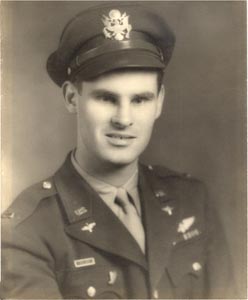

Remember...
Robert Elbon Stalnaker
1922-1953
"In war you win or lose, live or die - and the difference is but an eyelash."
General Douglas MacArthur |
Remember...Robert Elbon Stalnaker
|
Robert graduated from Huntington High School in 1939. He attended West Virginia Business College in Huntington, and after graduation worked as a clerk for the West Virginia State Road Commission in Huntington.
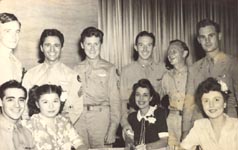 |
On January 7, 1942, Robert enlisted as a private in the Army Air Corps at Fort Thomas, Kentucky. He received his commission as lieutenant at Deming Officer Training School in Deming, New Mexico, in January 1943, where he also received training in navigation. In May 1944 Robert transferred to Hunter Army Air Field near Savannah, Georgia, for training aboard a B-17G and was assigned to Crew 122 as a bombardier. Robert went to England with the 8th Air Force in June 1944. |
| On July 16, 1944, Robert was a bombardier/navigator of a B-17 that participated in a bombing mission over Germany. Failing to return, he was declared missing in action. According to his sister Mary Childers, the plane was shot down over Germany and Robert was captured. He was among a group of prisoners being transported by truck to a POW camp when they were rescued by German partisans and helped across the French border. With the aid of the French underground they crossed the Swiss border, where they stayed until they were freed in an exchange of German POWs. On August 11, 1944, Robert's parents were notified that he was alive and safe. After his ordeal, Robert received a 21-day leave to visit home before returning to England, where he continued his service with the 8th Air Force until the war was over. | 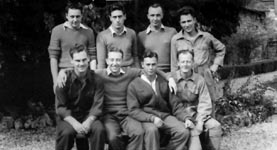 |
| On December 29, 1951, Robert married Betty [James] Frazier, a girl he had known since high school. They got married in Pikeville, Kentucky, and traveled throughout southern Kentucky on their honeymoon. After the trip, Robert returned to Biloxi and was then transferred to Forbes Air base near Topeka, Kansas. | 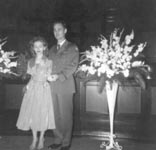 and Betty James Frazier |
The United States State Department officially released information that the US RB-50G was the victim of an unprovoked attack by two Russian MiG-17 fighters while on a routine navigational training exercise in international airspace over the Sea of Japan. In fact, the US RB-50G was involved in a ferreting operation, and in order to provoke the Russians, had flown into the danger zone of the harbor at Vladivostok, which was home to the Soviet's Pacific fleet.
The Soviet government maintained that about 6:00 AM on the morning of July 29, 1953, a US Air Force RB-50G aircraft violated the boundary of the USSR in the region of Cape Gamov and flew through their airspace to the area of Ajton Island near Vladivostok. The Soviets claimed that two Russian MiG-17 fighter aircraft approached the US RB-50G with the intention of showing the crew that they were within the boundaries of the USSR and urging them to leave Soviet airspace. The Soviets stated that the US RB-50G aircraft was last seen flying out to sea and they had no further knowledge of the fate of the plane or its crew. However, according to Captain Roche, several Russian boats were in the area immediately after the crash, and crew members of the rescue planes searching the site also reported sightings of Russian boats and planes in the area that may have picked up other possible survivors or remains.
Throughout the 1950s and early 1960s the US government made repeated requests to the Soviet Foreign Ministry for information regarding the July 29, 1953 attack on the US Air Force RB-50G plane but received little no response. In June 1992 Russian President Boris Yeltsin admitted that the Soviets had shot down nine US planes during the 1950s and held twelve of the survivors prisoner. It is not know whether any of these prisoners were crew members aboard the US RB-50G which was shot down in 1953. In November 1955, Robert Stalnaker was officially pronounced dead by the US Air Force.
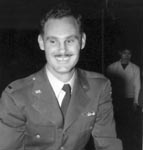 |
Robert Stalnaker is survived by his sister Mary Childers. His mother Lula [Stalnaker] Wilkinson passed away in 1966. His older brother Randall Harold had died in 1939, and his father passed away in 1934. At the time he was shot down, Robert Stalnaker left his wife Betty [James] Frazier and a stepson James Frazier. |

West Virginia Archives and History welcomes any additional information that can be provided about these veterans, including photographs, family names, letters and other relevant personal history.